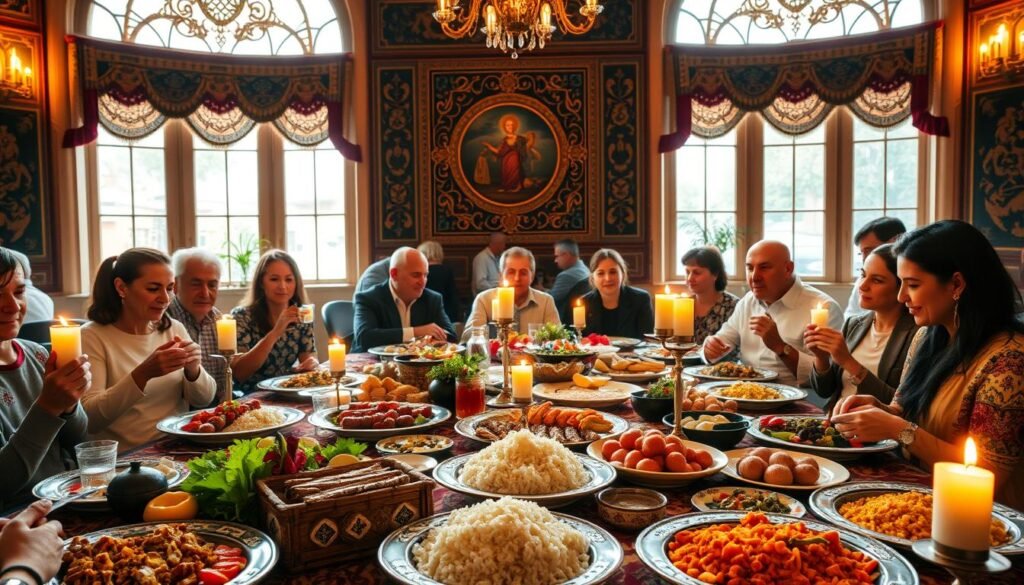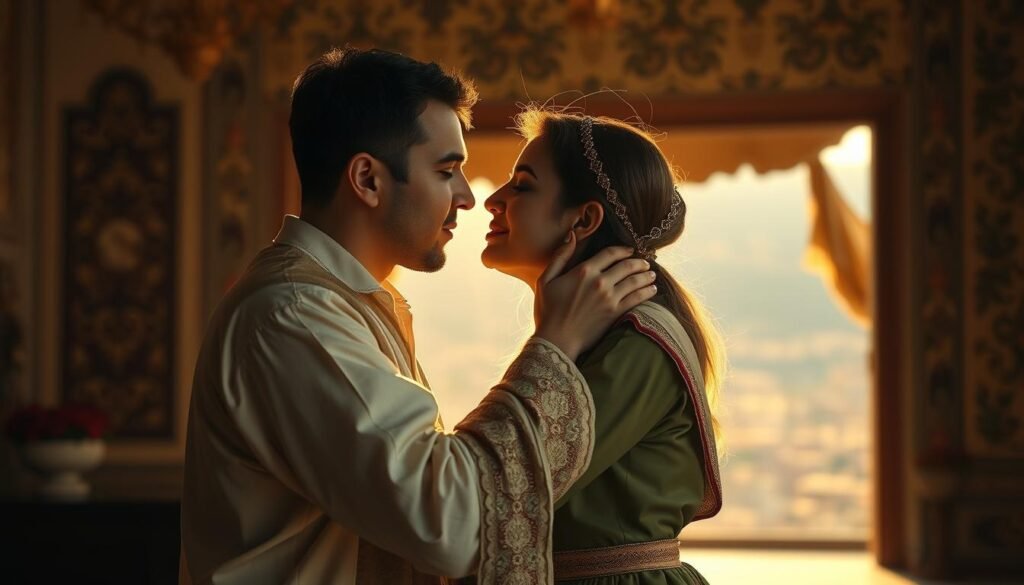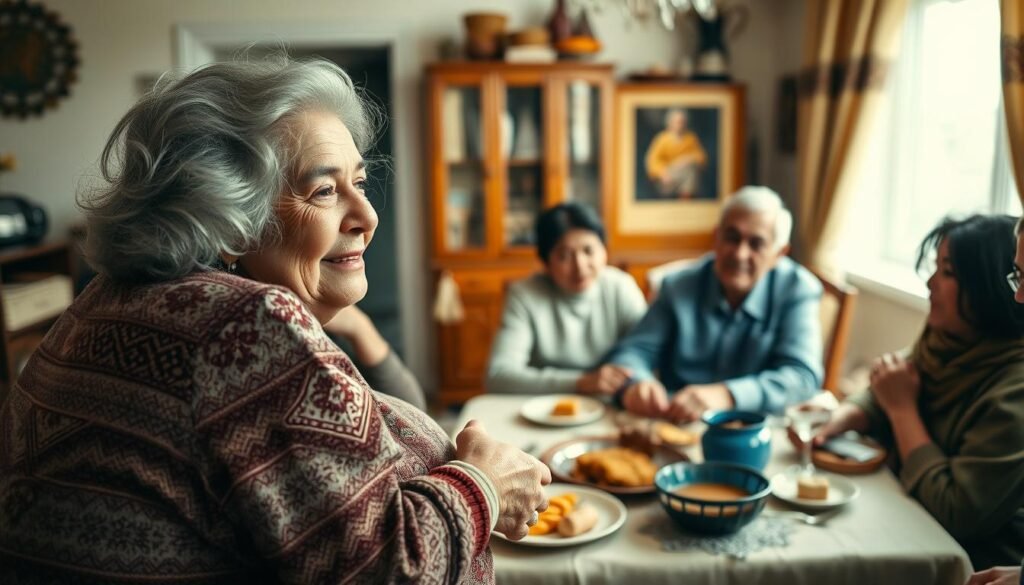Hosting someone from Armenia? Armenian hospitality is more than just being polite. It’s a way to connect deeply with others. When you share meals and make respectful gestures, you build trust. This is true whether you’re at home or online, like on Armenian cultural etiquette guides.
These customs, born from history, guide how Armenians in the U.S. greet guests. They show the importance of welcoming others warmly.
Key Takeaways
- Armenian hospitality traditions demand generosity and warmth in every interaction.
- Small gestures, like bringing a modest gift, show respect in Armenian guest customs.
- Family and food are central to Armenian cultural etiquette during visits.
- Modern Armenian communities, including those on Armenian Passion, value these customs when building relationships.
- Misunderstanding etiquette can create awkwardness—learning these norms avoids that.
Understanding Armenian Hospitality Culture
Armenian hospitality is more than a tradition; it’s a legacy. It shows the people’s strength and community spirit. This tradition helps Armenians connect, even in today’s world. For those using Armenian Passion, understanding these roots can help build better relationships.
The Historical Roots of Armenian Hospitality
Armenian hospitality goes back to ancient times. It was shaped by the Silk Road and hard survival conditions. Travelers found shelter with host families, creating a bond where “guest is family.”
Even through tough times, this tradition stayed strong. As anthropologist Vartan Haroutunian says, “Hospitality here isn’t optional—it’s survival encoded in identity.”
Core Values in Armenian Social Interactions
Armenian social values focus on respect and generosity. Key values include:
- Antsabz—unconditional welcome, regardless of circumstances
- Sharing resources, like dolma or lavash, shows generosity
- Reciprocity: hosts expect guests to leave “lighter,” while guests show gratitude
Regional Variations in Armenian Hospitality Customs
In Western Armenia (modern Turkey), customs are elegant and discreet. Eastern Armenia (Republic of Armenia) shows more abundance. Diaspora communities, like in Glendale, California, mix these traditions with modern ways.
This mix keeps traditional Armenian hospitality alive. It helps Armenian Passion users connect across cultures today.
Greeting Armenian Guests: First Impressions Matter
Armenian greeting customs are key to a good visit. A warm hug, a firm handshake, or a light kiss on the cheek shows respect. These actions highlight Armenian social protocol, where being welcoming is very important.
When you host Armenian friends, greet each one personally. A smile and direct eye contact make your welcome more sincere.
- Handshakes are common between strangers or formal settings.
- Family and close friends often greet with three cheek kisses, alternating sides.
- Men may pat a shoulder or chest to show camaraderie.
After saying hello, ask guests to remove their shoes. Then, offer them slippers. Serving tea or water right away is a long-standing tradition. This small act is mentioned in this article as a way to build community ties.
For those meeting Armenian partners online, like on Armenian Passion, knowing these customs is key. A cold or hasty greeting can make a bad impression. So, be warm and let cultural norms guide you.
What is the Etiquette for Armenian Guests? Essential Protocols
Hosting Armenian guests is a mix of old traditions and new ways. It shows Armenian cultural customs and Armenian American customs. These rules help everyone feel welcome and respected, in both family and romantic settings.
Host Responsibilities
- Offer plenty of food and drinks, as it’s a sign of respect.
- Be friendly by talking to guests and making sure they’re comfortable.
- Don’t let guests leave without something small as a thank you.
Guest Expectations
Guests should bring a gift, like wine, sweets, or something for the home. Saying thank you is important. It’s key to leave on time but not too early, to avoid being rude.
Generational Shifts
Older Armenian guest etiquette is formal, but younger folks in the U.S. mix it up. Modern hosts might focus on comfort over strict rules. Knowing these differences is helpful, like when dating and meeting the family. Sites like Armenian Passion help people find meaningful connections, understanding these cultural layers.
Food and Dining Customs When Hosting Armenian Guests

Sharing meals is key in Armenian culture, showing warmth and respect. Hosting Armenian guests means following Armenian dining customs to make your event feel real and welcoming. These customs help build connections, which is great for those exploring Armenian heritage online.
Traditional Armenian Dishes to Consider Serving
- Khorovats: Grilled meat with herbs, a staple at gatherings
- Dolma: Stuffed grape leaves or vegetables
- Lavash: Thin flatbread served with every meal
- Kookoo: Herb-packed savory cakes
These dishes are part of Armenian food traditions and are loved by families and couples, even those who meet online.
Seating Arrangements and Table Manners
| Position | Who Sits Here? |
|---|---|
| Head of table | Elderly guests or honored visitors |
| Left/right sides | Family members or younger guests |
Armenian table etiquette means elders are served first. Guests should wait for hosts to invite them to eat. Hands are washed before meals.
The Ritual of Coffee and Dessert
“A cup of coffee is a cup of friendship.” – Armenian proverb
After meals, serve strong Armenian coffee with sugar. Desserts like paklava come next. Some families enjoy reading fortunes in coffee grounds—a fun cultural tradition!
Dietary Considerations and Restrictions
Ask guests about fasting periods like Lent or allergies. Vegetarian dishes are common during fasts. Use Armenian Passion’s messaging tools to discuss preferences with matches.
Gift-Giving Traditions in Armenian Culture
Gift-giving is key in Armenian gift-giving traditions. It shows respect and warmth. Presents are given during visits, holidays, or special times. This reflects Armenian social etiquette values like generosity and gratitude.
When you visit Armenian families, thoughtful gifts make a big impact. They show you care and understand their culture.
- Cognac: A bottle of Armenian brandy, like Noy or Moskovskoye, honors cultural pride.
- Sweets: Boxes of Armenian hospitality gifts like khorovats or badam (almonds) express warmth.
- Flowers: Even-numbered bouquets (except for funerals) or home decor items like pottery show thoughtfulness.
Gifts should be wrapped simply but elegantly. It’s common for people to politely decline once or twice before accepting. This shows humility in Armenian social etiquette.
It makes gifts feel more heartfelt than just a transaction.
For online connections, knowing these customs builds trust. Sites like Armenian Passion help learn about cultural values. When meeting families, gifts like handmade crafts or sweets can help break the ice and celebrate shared heritage.
Navigating Conversation Topics with Armenian Guests
Choosing the right Armenian conversation topics can make a simple chat meaningful. For those connecting on platforms like Armenian Passion, knowing these details is key. It helps build trust in the Armenian community in America. Talking about Armenian cultural values shows respect and makes the conversation enjoyable.
Engaging Topics That Show Cultural Appreciation
Begin with topics that celebrate shared heritage:
- Ask about family traditions or regional dialects.
- Show interest in Armenian cultural values like hospitality or resilience.
- Discuss music (e.g., Komitas Vardapet’s hymns) or art (e.g., Vardges Sureniants’ paintings).
- Talk food! Mention dishes like dolma or lavash to spark pride.

Sensitive Subjects to Approach With Care
Be careful and empathetic when discussing certain topics:
- The Armenian Genocide: Acknowledge historical pain without prying.
- Politics in Armenia or Nagorno-Karabakh: Let guests guide the discussion.
- Religious practices: Respect differences in traditions without assumptions.
The Role of Humor in Armenian Social Settings
Armenian humor often includes light teasing or witty remarks. A community in America may mix humor with nostalgia. Use self-deprecating jokes carefully, and avoid sarcasm on sensitive issues. As one community member noted, “A good joke about bad weather in Boston? That’s a safe start.”
Mastering these Armenian conversation topics helps build rapport, whether hosting a dinner or dating through Armenian Passion. Respecting cultural values creates lasting bonds, whether at home or online.
Common Mistakes to Avoid When Hosting Armenian Guests
Hosting Armenian guests? Avoid Armenian cultural mistakes by knowing what to watch for. Small oversights can clash with Armenian social protocol, so stay mindful of traditions.
- Never refuse food—declining a host’s offerings may cause offense.
- Arrive late—promptness shows respect for Armenian hospitality errors avoidance.
- Ignore elders—always prioritize speaking to older guests first.
- Discuss politics lightly—conflicts over historical topics are sensitive.
If an error happens, Armenian social protocol encourages grace. A sincere apology paired with a gesture like refilling a guest’s coffee often mends moments. As one community member shared:
“A smile and ‘I’ll do better next time’ goes a long way.”
For those using Armenian Passion, mastering these details builds trust. Dating success hinges on cultural awareness—showing you understand traditions like proper gift-giving or seating arrangements can deepen connections. Remember: Armenian hospitality is rooted in heart, not perfection. Stay genuine, and your efforts will be appreciated.
Conclusion: Embracing Armenian Hospitality in Modern America
Armenian family traditions, like hospitality, are key in Armenian American culture. Even as communities change, these values stay strong. They help keep relationships close by balancing old customs with new ways.
These traditions shape how Armenian Americans welcome guests and share meals. They also build trust in personal and dating relationships. This is important for everyone.
Looking into Armenian dating customs on sites like Armenian Passion shows us how to connect respectfully. The article on Armenian dating customs shows how tradition and modernity mix. Sites like Armenian Passion help singles honor their culture while finding love.
Embracing Armenian American culture means celebrating its warmth and openness. Whether hosting guests or finding community, respect and curiosity are key. Platforms like Armenian Passion help people connect, making traditions like shared meals or gift-giving relevant today.
FAQ
What should I know about Armenian hospitality before hosting guests?
Armenian hospitality is all about being generous with food and attentive to guests. It’s important to make your guests feel at home and comfortable.
Are there specific etiquette rules for greeting Armenian guests?
Yes! Greet Armenian guests warmly with a handshake or cheek kisses. Saying hello in both English and Armenian can make it even better.
What types of gifts should I consider bringing when visiting Armenian homes?
Good gifts are cognac, sweets, or flowers. It’s polite to say no first before accepting, which is a big part of Armenian culture.
What are common conversation topics to engage Armenian guests?
Talking about Armenian history, arts, and family is usually a hit. But, be careful with topics like the Armenian Genocide to keep the conversation respectful.
What are some common mistakes to avoid when hosting Armenian guests?
Don’t make the mistake of not enough food, rushing meals, or ignoring older guests. Knowing these customs can make you a better host.
How should I handle a mistake in etiquette while hosting?
If you mess up, apologize sincerely and show you’re willing to learn. Most guests will appreciate your effort to fix it.
How is food important in Armenian hospitality?
Food is very important in Armenian culture. Serving traditional dishes shows respect and strengthens bonds. It’s seen as a sign of love and care.
What are the seating arrangements during meals in Armenian culture?
Elders usually sit in the most honored spots at the table. Knowing this can make your hosting better and show respect for their traditions.
Why is understanding Armenian etiquette beneficial for dating?
Knowing these customs can help build deeper connections, which is great for dating. It can lead to more meaningful relationships, like those found on Armenian Passion.




